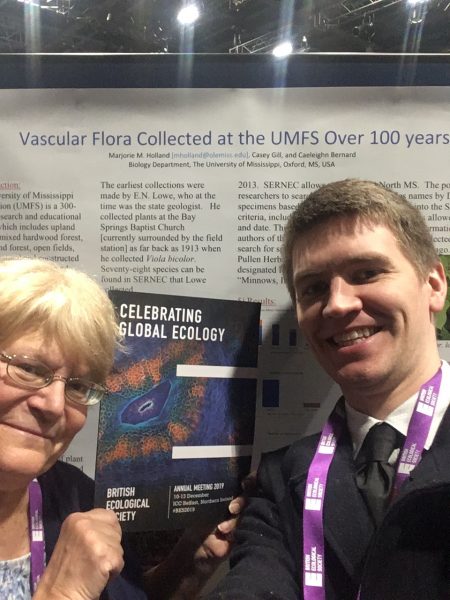 January 16, 2020
January 16, 2020
Natural history collections in museums act as historical databases that can reveal changes in the geographical distributions of animal and plant species over time. A recent presentation by Dr. Marge Holland, a Professional Affiliate of the Center for Biodiversity & Conservation Research, and Professor Emerita in the Department of Biology at the University of Mississippi, demonstrates how plant collections can serve as essential reference tools for scientists. These collections allow investigators to detect the spread of invasive introduced species and to monitor the status of our native flora as well. Working with two undergraduate research students, Casey Gill and Caeleighn Bernard, Dr. Holland prepared a research presentation entitled “Vascular flora collected at the University of Mississippi Field Station (UMFS) over 100 years” for the annual meeting of the British Ecological Society, held in Belfast, Northern Ireland, from December 10-13, 2019.
Using data from plant collections made by Dr. Holland and her students since 1996, along with records from other botanists who contributed specimens to the Pullen Herbarium at Ole Miss, the researchers concluded that a total of 539 plant species have been collected and documented from the UMFS. The collections of several Mississippi botanists are described in the research poster, ranging from Dr. E.N. Lowe [early 1900’s] to Dr. Thomas Pullen [mid-1900’s] to Dr. Maeburn Huneycutt [late 1900’s] to Dr. Lucile McCook [early 2000’s].
Increasingly natural history collection records are becoming available to both scientific users and the general public via the internet. Dr. Holland reveals that “Investigators from numerous countries visited the poster to ask questions about the United States Department of Agriculture Plant Database and the Southeast Regional Network on Expertise and Collections (SERNEC) database.” Indeed Dr. Lucile McCook, Director of the Pullen Herbarium, explains that “the University of Mississippi has received funding from the National Science Foundation to image all of its ~80,000 specimens and transform the collection data into a digital format that allows people to search our collections on-line.” SERNEC is a community-based web portal, where the specimens of 115 herbaria can be searched by scientific name, common name, plant family, geographic area, and other key words. An herbarium is a curated collection of flattened dried plants that is made available for the study of plant species distributions, plant genetics and phenology (seasonal change).
Dr. Holland focused her presentation on the UMFS, which she directed from 1995-2003. According to Dr. Scott Knight, current UMFS director, “This type of research is particularly important to the UMFS in that it provides vital records in support of our ongoing mission of providing a venue for ecological research. Perhaps more importantly, long-term data sets of flora and fauna such as the ones collected by Dr. Holland, serve to document climate related changes and other anthropogenic impacts within the ecoregion.”
“Over 1,000 ecologists from 40 countries attended the BES meeting” states Dr. Holland, “and by coming together in one place they were able to share new discoveries, evaluate the effectiveness of existing research methodologies, and discuss potential collaboration on a global scale. Of course, limited research funding is always a problem given the scale of the biodiversity crisis worldwide, but scientific meetings like this enable us to encourage cooperative use of resources such as the Pullen herbarium, SERNEC and the UMFS with colleagues all over the planet.” Shown with Dr. Holland in photo is Dr. Mark McCauley, a post-doctoral scientist in the Department of Biology. Dr. Holland’s research poster is available for download.